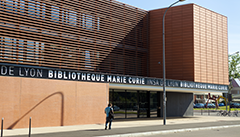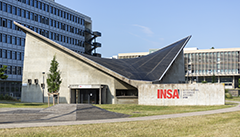
Sciences & Société
Soutenance de thèse : Éléonore GENDRY
Évolutions des régimes de travail industriel et mutations urbaines: L’exemple de l’entreprise Berliet et de l’agglomération lyonnaise : 1950-2020
Doctorante : Éléonore GENDRY
Laboratoire INSA : EVS
École doctorale : ED483 : ScSo (Histoire, Géographie, Aménagement, Urbanisme, Archéologie, Science Politique, Scociologie, Anthropologie)
Les relations entre l’activité et l’urbanisation sont aussi anciennes que l’existence des villes. Si ces liens ont particulièrement été étudiés pour les périodes du XIXe siècle et du début du XXe siècle, leur observation n’est que peu détaillée après-guerre. Or, l’industrie n’a jamais été aussi présente dans notre environnement dessinant des sociétés hyper- industrielles caractérisées par un continuum entre la production de biens et de services, la consommation de masse, les industries financières et culturelles, engendré par le développement du numérique. Pour saisir plus précisément les transformations urbaines héritées des évolutions de l’industrie, cette recherche s’intéresse aux mutations du travail ; ces dernières étant elles aussi liées aux changements industriels.
L’étude porte plus particulièrement sur l’usine de production de véhicules industriels Berliet implantée depuis 1917 sur les communes de Vénissieux et de Saint-Priest dans l’agglomération lyonnaise. Pour appréhender les mutations du travail au sein de cette entreprise, l’enquête s’intéresse à l’évolution de la production des moteurs Berliet entre 1950 et 2020 à l’aide des traces laissées par ces changements : journaux d’entreprise, correspondances, rapports et ouvrages spécialisés, plans ou encore photographies. Des entretiens menés auprès d’actuels ou d’anciens salariés de l’entreprise explicitent certaines traces lacunaires.
À l’issue de cette enquête, les transformations urbaines liées aux mutations du « travail industriel » s’observent autour de l’organisation et de la distribution de l’appareil productif, de l’habitat et des infrastructures de transport. Considérant l’observation de ces interdépendances entre l’industrie et la ville, il peut être avancé que des états urbano-industriels se distinguent au sein de l’agglomération lyonnaise simplifiés en deux morphologies urbaines idéales-typiques : l’une industrielle (1950-1973), l’autre hyper- industrielle (2000-2020). L’observation de ces états, caractérisés par des encastrements multiples entre industries, logements, infrastructures, etc., incite à concevoir les politiques industrielles comme une politique globale s’intéressant à l’activité productive, mais aussi aux questions du logement ou des déplacements.
Informations complémentaires
-
Amphithéâtre Ouest, Bâtiment des Humanités, INSA-Lyon (Villeurbanne)
Derniers évènements
UNITECH - Assemblée générale 2025
Du 31 aoû au 05 sep
Sciences & Société
Soutenance de thèse : Fang WAN
Multi-criteria optimization for the management of intensive care beds in an epidemic context
Doctorante : Fang WAN
Laboratoire INSA : DISP
Ecole doctorale : ED512 Infomaths
In this study, we explore the various challenges of healthcare resource management in the context of the COVID-19 pandemic, such as multiple uncertainties, multi-objective considerations, and diverse research subjects. The focus is on issues like medical resource allocation, priority setting, predictive models, and hyperparameter optimization. First, we conduct an in-depth investigation into intensive care units (ICU) bed allocation strategies, primarily considering how to reasonably distribute ICU beds among different patient types to maximize admission rates, patient satisfaction, and resource utilization, while maintaining scheduling stability under the influence of uncertainties. Then, Considering the upstream resources related to ICUs, especially the direct impact of operating room (OR) on ICU bed allocation, we coordinated the optimization of the OR and ICU modules. We examined the impact of OR allocation on ICU bed distribution, particularly in the context of random emergency patient arrivals. We explored how to minimize peak ICU bed demand, reduce delays in elective surgeries, and minimize healthcare staff overtime. Next, due to the random arrival of emergency patients, uncertain surgery duration, and prolonged length of stays (LOS) of patients in ICU, we first predicted emergency patient arrivals, patients' surgery durations and LOS, and then allocated ORs for both emergency and elective patients. Our goal is to provide timely emergency services and improve the utilization of ORs and ICU beds while minimizing the cancellation of elective surgeries. We also compared the performance of large language model (LLM) and traditional algorithms in the allocation of ORs and ICU beds. The performance of the models was further improved through hyperparameter optimization. Finally, we summarize the key findings of this research and provide suggestions for future research directions, particularly in improving the resilience and adaptability of medical resource management systems.
Informations complémentaires
-
Salle Blake & Mortimer, Bâtiment Jules Verne, INSA-Lyon (Villeurbanne)
Derniers évènements
UNITECH - Assemblée générale 2025
Du 31 aoû au 05 sep
Sciences & Société
Soutenance de thèse : Bjarne Vincent
« Experimental and numerical study of three-dimensional flows generated by ultrasounds »
Doctorante : Bjarne VINCENT
Laboratoire INSA : LMFA
École doctorale : ED162 : MEGA de Lyon (Mécanique, Energétique, Génie civil, Acoustique)
L’acoustic streaming est un écoulement entraîné par l’atténuation d’ondes acoustiques se propageant dans un fluide. Etant peu intrusif, le streaming est idéal pour mettre en mouvement des fluides difficiles d’accès, comme lors de la solidification de semiconducteurs liquides. Dans ces procédés, mélanger le bain fondu et contrôler les instabilités hydrodynamiques est essentiel pour assurer la qualité du lingot solidifié. Ce travail de thèse vise à caractériser le streaming généré par un faisceau ultrasonore avec ou sans réflexion, en vue d’une utilisation à long terme pour le contrôle et le mélange du bain fondu.
Tout d’abord, je caractérise un jet de streaming dans une cavité cylindrique fermée dont la longueur excède la longueur d’atténuation des ondes acoustiques. A l’aide de simulations numériques, j’obtiens des lois d’échelle décrivant l’évolution de la vitesse du jet le long de son axe, permettant ainsi d’avoir une vue d’ensemble des différents régimes d’écoulement.
Ensuite, j’étudie la stabilité de cet écoulement pour différentes tailles de cavité. L’impact du jet sur la paroi opposée à la source acoustique joue un rôle prépondérant dans la déstabilisation de l’écoulement. Outre son effet stabilisant, confiner l’écoulement affecte l’instabilité primaire qui peut être oscillatoire ou non-oscillatoire, sous-critique ou supercritique. Le changement de topologie de la perturbation instable s’explique par l’étude de ses points critiques.
Enfin, j’étudie un écoulement de streaming tri-dimensionnel en vue d’effectuer du mélange. Ce travail expérimental est réalisé dans une cavité cubique remplie d’eau. L’écoulement est forcé par un champ hélicoïdal résultant de plusieurs réflexions d’un seul faisceau sur les parois de la cavité. Avec des mesures optiques de pointe, j’identifie les structures majeures de l’écoulement, et analyse l’évolution de leurs vitesses avec l’intensité du forçage. Je montre que les lois d’échelle d’un jet droit sont valables pour cet écoulement 3D, et peuvent donc être utilisées pour le dimensionner.
Informations complémentaires
-
Amphithéâtre Clémence Augustine Royer, Bâtiment Jacqueline Ferrand, INSA-Lyon (Villeurbanne)
Mots clés
Derniers évènements
UNITECH - Assemblée générale 2025
Du 31 aoû au 05 sep
Sciences & Société
Soutenance de thèse : Antoine LEJEUNE
Étude thermomécanique des émaux sur substrat verrier pour l'industrie automobile
Doctorant : Antoine LEJEUNE
Laboratoire INSA : MatéIS
École doctorale : ED34 : Matériaux de Lyon
Les émaux sont des revêtements inorganiques déposés à la surface du verre dans le but d’apporter une fonction d’opacification au vitrage. Ces revêtements sont des matériaux multi-phasés constitués de fritte de verre, de pigments noirs inorganiques et dans certains cas de charges minérales. Les traitements thermiques appliqués au verre émaillé sont connus pour générer des défauts liés à la présence d’émail : fragilisation mécanique du substrat, genèse de défauts optiques. La compréhension des interactions physico- chimiques entre le substrat verrier et le revêtement d’émail est indispensable afin de limiter ces défauts. Dans ce sens, trois émaux chimiquement différents ont été sélectionnés. La combinaison d’une approche locale et globale des évolutions microstructurales de ces émaux, complémentée par une approche in-situ a été développée. L’analyse a mis en évidence la présence de différents systèmes de fritte verrière, dont un cristallisant en température, à l’origine de l’inhibition du frittage de la couche d’émail. Un protocole de mesure de la contrainte moyenne dans la couche d’émail déposée sur un substrat inerte de silicium a été développé. Cette méthode a montré que l’émail se comportait de manière viscoélastique au-dessus de sa transition vitreuse, au-delà de laquelle la contrainte moyenne dans le revêtement relaxe entièrement. Au refroidissement, les contraintes se régénèrent à une température qui dépend de la fraction volumique de phases rigides, fonction du taux de cristallisation. Ainsi, un réseau percolant se forme et domine l’écoulement visqueux de la matrice vitreuse. Finalement, les interactions chimiques ont été étudiées en déposant l’émail sur substrat verrier. Les résultats ont mis en évidence un échange Li↔Na dont la profondeur dans le verre est proportionnelle à la déformation du verre émaillé à iso-température. Ces travaux ont mis en évidence l’effet des transformations structurales et de la composition chimique de l’émail sur son comportement thermomécanique et rhéologique.
Informations complémentaires
-
Amphithéâtre Emilie du Châtelet (Bibliothèque Marie Curie) - Villeurbanne
Derniers évènements
UNITECH - Assemblée générale 2025
Du 31 aoû au 05 sep
Sciences & Société
Soutenance de thèse : Joaquin Eduardo CORNEJO FUENTES
Matrix-free weighted quadrature isogeometric analysis applied to thermal and mechanical simulations
Doctorant : Joaquin Eduardo CORNEJO FUENTES
Laboratoire INSA : LaMCoS
École doctorale : ED162 : MEGA de Lyon (Mécanique, Énergétique, Génie civil, Acoustique)
Ce travail explore le potentiel de l'Analyse Isogéométrique (IGA) pour améliorer les simulations numériques industrielles, en particulier pour le transfert de chaleur et l'élastoplasticité. Bien que la méthode des éléments finis soit couramment utilisée en ingénierie, elle présente des limites de précision et d'efficacité, surtout pour les géométries complexes. L'IGA, en intégrant des techniques avancées comme les méthodes sans matrice, à quadrature pondérée et fast-diagonalization, pourrait offrir une alternative plus précise et efficace. Cette étude démontre l'application de ces méthodes à des équations aux dérivées partielles elliptiques, ainsi que pour des problèmes qui évoluent au cours du temps. Une approche espace-temps pour les problèmes paraboliques non linéaires est également proposée, montrant des performances supérieures aux méthodes actuelles. Cependant, des défis subsistent pour appliquer ces méthodes à des géométries plus complexes et à des applications industrielles à grande échelle. Ce travail ouvre des perspectives pour des simulations plus rapides et fiables, remettant en question les pratiques traditionnelles en ingénierie computationnelle.
Informations complémentaires
-
Amphithéâtre Clémence Augustine Royer, Bâtiment Jacqueline Ferrand, INSA-Lyon (Villeurbanne)
Derniers évènements
UNITECH - Assemblée générale 2025
Du 31 aoû au 05 sep
Sciences & Société
Soutenance de thèse : Ahmed Sabry Eltaher AHMED
High-performance cooling of power semiconductor devices embedded in a printed circuit board
Doctorant : Ahmed Sabry Eltaher AHMED
Laboratoire INSA : AMPERE
École doctorale : ED162 : MEGA de Lyon (Mécanique, Energétique, Génie civil, Acoustique)
L'intégration de dispositifs semi-conducteurs de puissance dans un circuit imprimé (PCB) est une solution prometteuse pour réduire les éléments parasites des circuits, simplifier le packaging des dispositifs et réduire les coûts. Cependant, la réduction continue de la taille des puces semi-conductrices, combinée à la faible conductivité thermique des couches diélectriques des PCB nécessitent des solutions de gestion thermique plus efficaces.
Dans ce projet de recherche, deux solutions de gestion thermique sont étudiées. Tout d'abord, un dissipateur de chaleur en graphite avec une haute conductivité thermique (1300 W/(m.K) dans le plan, et 15 W/(m.K) hors plan) est intégré dans le PCB. Deuxièmement, une solution d'extraction de chaleur basée sur la technique de refroidissement par jet d'eau impactant est mise en œuvre pour collecter la chaleur à la surface du PCB. Pour la solution de dissipation de chaleur, les valeurs des résistances thermiques jonction-environnement et jonction-boîtier (RthJA et RthJC, respectivement), des variantes de PCB avec des diodes et des puces MOSFET intégrées, sont réduites jusqu'à 38 % pour RthJA et 30 % pour RthJC, d'après les mesures. Pour la solution d'extraction de chaleur, le refroidisseur à jet d'eau (JIC) présenté réduit expérimentalement RthJA de 33 % par rapport à une plaque froide conventionnelle. Le coefficient de transfert de chaleur effectif (HTC) du JIC est calculé par simulations et s'élève à environ 43 kW/(m².K) avec une chute de pression de 9,7 kPa. Cette performance permet d'atteindre une densité de puissance de 865 W/cm² sans dépasser la limite de température de jonction de 175°C. Augmenter la conductivité thermique de la couche isolante par un facteur de 10 permettra d'atteindre 993 W/cm² (très proche de l'objectif de 1000 W/cm²).
Informations complémentaires
-
Amphithéâtre Ouest, Bâtiment des Humanités, INSA-Lyon (Villeurbanne)
Derniers évènements
UNITECH - Assemblée générale 2025
Du 31 aoû au 05 sep
Sciences & Société
Soutenance de thèse : Eliott BRUN
Capteurs multiphysiques miniaturisés et intégrés pour contrôles et analyses structures
Doctorant : Eliott BRUN
Laboratoire INSA : LGEF
École doctorale : ED160 : EEA (Electronique, Electrotechnique, Automatique)
Les méthodes actuelles de contrôle non destructif (CND) se basent majoritairement sur l'utilisation de capteurs manuels pour détecter des défauts tels que les fissures et les porosités, notamment lors des phases de production et de maintenance. Toutefois, ces techniques sont souvent limitées par le coût, la taille des équipements, et la nécessité d'une intervention humaine, ce qui les rend inadaptées à certaines applications industrielles où l'accès est difficile ou dangereux. Cette thèse explore la miniaturisation des capteurs CND à ultrasons et à courants de Foucault pour répondre aux besoins de surveillance en continu des structures, une approche intégrée dans le concept de suivi de santé des structures (SHM). L'objectif est de développer des capteurs légers, intégrables directement dans les structures, capables de surveiller en temps réel leur état tout en minimisant les coûts et les risques associés aux méthodes conventionnelles. Les travaux se concentrent sur deux axes principaux : la miniaturisation des capteurs à courants de Foucault, via l'utilisation de bobines plates imprimées ou sérigraphiées, et la conception de capteurs ultrasoniques miniaturisés basés sur des composites piézoélectriques. Pour les capteurs à courants de Foucault, l'accent est mis sur l'optimisation du facteur de qualité des bobines pour maximiser leur efficacité. Les capteurs ultrasoniques, quant à eux, sont développés à partir de films composites polymère-piézoélectriques, optimisés pour fonctionner à haute température. Les résultats démontrent que ces capteurs miniaturisés offrent des performances prometteuses en termes de détection des défauts, de mesures d'épaisseur et de durabilité en environnements extrêmes. Cette thèse pose ainsi les bases pour une nouvelle génération de capteurs CND miniaturisés, ouvrant la voie à une adoption plus large du SHM dans les secteurs tels que l'aéronautique, le ferroviaire, et l'énergie. Les perspectives de développement sont nombreuses, avec des applications potentielles dans diverses industries critiques.
Informations complémentaires
-
Amphithéâtre 5040014, AE1, Département Génie électrique, INSA Lyon (Villeurbanne)
Derniers évènements
UNITECH - Assemblée générale 2025
Du 31 aoû au 05 sep
Sciences & Société
Soutenance de thèse : Sébastien DAGUE
Characterization and modelling of phase transformations and microstructures of cold rolled dual phase steels after heat treatment
Doctorant : Sébastien DAGUE
Laboratoire INSA : MATEIS
École doctorale : ED34 : Matériaux de Lyon
L’objectif de cette thèse était de contribuer au développement et à la compréhension des phénomènes physiques pilotant les évolutions microstructurales d’aciers Dual-Phase, principalement lors des phases de refroidissement. Dans un souci d’utilisation sur des lignes de production industrielles, des outils numériques à champ moyen à base physique ont été développés, ceux-ci étant utilisables pour une large gamme de compositions chimiques et de paramètres du cycle thermique. Une calibration des modèles sur des aciers ternaires issus de coulées de laboratoire a été effectuée avant leur validation sur deux nuances industrielles.
Un modèle, développé dans une thèse antérieure, pour la transformation de phase entre la ferrite et l’austénite ayant lieu lors de la phase de chauffage et maintien isotherme a été modifié avec pour objectif de le rendre plus robuste d’un point de vue numérique.
Un autre modèle visant à simuler la transformation de l’austénite en ferrite, lors de refroidissements lents continus, a été développé. Ce modèle, calibré sur des alliages ternaires Fe-C-Mn, est basé sur une description de la croissance de ferrite faisant intervenir des lois de germination et croissance. Dans un but de rapidité de calcul, ce modèle a été implémenté en langage VBA (Excel). Il a été testé sur différentes compositions d’alliages et il a été possible de trouver des lois de prédiction pour les paramètres du modèle, en fonction de la composition en manganèse de l’alliage et des conditions de refroidissement.
Pour finir, la formation de bainite en condition isotherme à 460°C et 500 °C a été étudiée en DRX in situ sur la ligne DiffAbs du Synchrotron SOLEIL. Le maintien de l’austénite a été mis en évidence lors d’un palier isotherme à 460°C ou à 500°C, pour deux alliages différents. Cette austénite peut ensuite être transformée en martensite lors du refroidissement rapide final, modifiant alors les caractéristiques mécaniques de l’alliage.
Informations complémentaires
-
Amphithéâtre Gaston Berger, INSA-Lyon (Villeurbanne)
Derniers évènements
UNITECH - Assemblée générale 2025
Du 31 aoû au 05 sep
Sciences & Société
Soutenance de thèse : Caroline MIYAZAKI
Optimization of hybrid aerated vertical/horizontal flow treatment wetland
Doctorante : Caroline MIYAZAKI
Laboratoire INSA : INRAE
École doctorale : ED206 Chimie de Lyon (Chimie, Procédés, Environnement)
The combination of stricter local regulations and the need for higher capacity plants has prompted companies in the wetland treatment sector to prioritize research and development initiatives aimed at enhancing total nitrogen (TN) removal and minimizing system footprints. In response to these challenges, it was created the Rhizosph'air system to be resilient, compact, and robust, with a capacity to serve communities of 2,000 to 10,000 PE. This thesis contributes to the optimization of total nitrogen (TN) removal while addressing operational challenges related to environmental protection and wastewater reuse. Chapter 2 provides an overview of key topics related to the Rhizosph'air system, including nature-based solutions (NbS) and aerated treatment wetlands (TW). It identifies key research areas for improvement, including oxygen transfer and nitrogen dynamics, to enhance TN removal. Chapter 3 is dedicated to the analysis of the impact of aeration strategies on system hydrodynamics. To this purpose, tracer tests have been employed to assess both internal and outlet responses. Hydraulic parameters and modeling provided valuable insights into the system's behavior. Chapter 4 examines a range of experimental conditions, demonstrating that inflow-based aeration strategies promote equilibrium between aerobic and anoxic environments, thereby optimizing TN removal. Furthermore, the strategy suggests using the primary filter for generating nitrates during aeration and allowing denitrifying bacteria to consume them during non-aeration periods and batch-hour. The utilization of organic carbon from raw wastewater is also a key aspect of this strategy. Finally, Chapter 5 examines the proposed aeration strategy, its limitations, and the resilience of the hybrid system. It also assesses the applicability of the N-k-C* model and investigates the potential for real-time aeration control using online sensors, including bending points and model predictions. This research advances the understanding of aeration processes and TN removal, offering innovative strategies for improving wetland treatment performance in small communities
Informations complémentaires
-
Salle ISA, 5 rue la Doua (Villeurbanne)
Derniers évènements
UNITECH - Assemblée générale 2025
Du 31 aoû au 05 sep
Sciences & Société
Soutenance de thèse : Zheheng LIU
Characterization of plastic strain localization in polycrystalline materials by means of 3D X-ray diffraction imaging techniques
Doctorant : Zheheng LIU
Laboratoire INSA : MATEIS
École doctorale : ED34 : Matériaux de Lyon
This thesis is part of the ANR 3DiPolyPlast project devoted to an in-depth study of the mechanisms leading to plastic strain localization in pure metals. 2D surface observations, 3D volume characterization, and numerical simulations are carried out in three simultaneous PhD projects. This thesis focuses on 3D characterization of strain localization using a combination of Topo-Tomography (TT) and Diffraction Contrast Tomography (DCT) - two synchrotron radiation near-field imaging techniques allowing for
1 micron spatial and 0.02-degree angular resolution. Two material systems have been studied: Ti-7Al alloy and pure Ni. In both cases the 6D algorithm is used to reconstruct the orientation field during initial stages of plastic deformation, which in turn is analysed for signatures of strain localization. Both the data acquisition scheme for TT and the 6D / 5D reconstruction algorithms for DCT and TT scans have been optimized. Theoretical analysis for the TT scan is performed to explore the limits of its reconstruction capacities and the methods to enhance them. Simulated diffraction data are used to study joint reconstructions of DCT and TT scans, illustrating possibilities and limitations of the optimized reconstruction framework. Contrary to Ti7Al, exhibiting clearly resolvable orientation contrasts in vicinity of slip bands, the diffraction data from pure Ni could not reveal slip bands, probably due to the weak and diffuse character of slip in this pure material. However, distinct structures in the orientation field were observed in directions perpendicular to the primary slip plane.
Informations complémentaires
-
Salle Auditorium, ESRF the European Synchrotron, 71 Avenue des Martyrs (Grenoble)

